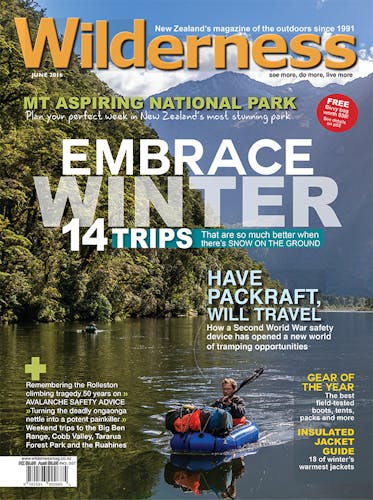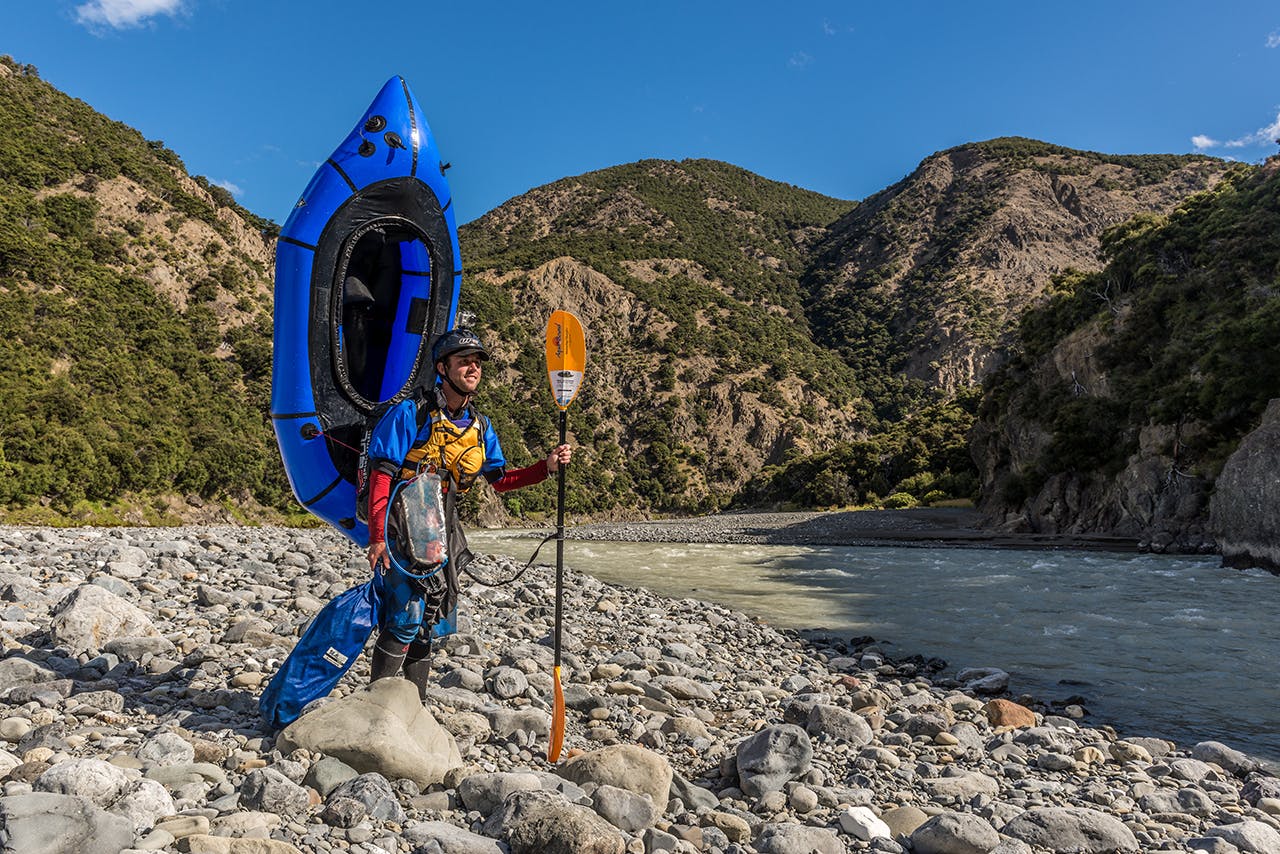If you’ve ever gazed longingly at a swiftly moving river while on a long and arduous tramp and thought there must be an easier way down the trail, you’re in luck
If tramping and paddling had a baby, it would be packrafting.
Packrafts are inflatable rafts that pack down as small as a one-man tent, and weigh as little as 2.5kg. You can carry them rolled up at the bottom of your pack, strapped to the outside for easy access, or on your back for short distances. They’re smaller than a raft, bigger than a kayak, and are intended for people who plan to tramp far and wide to access remote rivers, or for the adventurous tramper who wants a multimodal approach to covering vast swaths of backcountry.
Packrafting has been around for at least a century, with rudimentary packable rafts used in North America as early as the mid-1800s. Nearly 100 years later, sturdier prototypes were manufactured as airplane survival equipment for the Second World War. After the war, the safety rafts began to be used for recreation, and in the 1970s, safety equipment company American Safety created lightweight rafts, designed to be used on calm waters. In the 80s, packrafting took an intrepid turn, when adventure racer Dick Griffith toted one of the American Safety rafts to Alaska for a wilderness race, sparking a trend that inspired companies such as Sherpa and Curtis Designs to develop smaller, more lightweight designs intended for recreation.
Packrafting as a sport quietly gained popularity in Alaska through the 80s and 90s, and in 2001 Alpacka Rafts was born. Founder Sheri Tingey made their first packraft so her son, Thor, could have a lightweight bushwhacking-friendly watercraft that could endure the rocky and frothy Alaskan backwaters. The sport has been steadily expanding ever since, with keen rafters exploring backcountry rivers and lakes all over the world. New Zealand has an emerging community of packrafters, with a contingent pooling on the South Island.
“New Zealand is one of the best places in the world to go packrafting,” Thor Tingey says. Tingey, who lives in Mancos, Colorado, now helps his mum run Alpacka. He says the New Zealand/Australian market is their third biggest, after America and Europe. Though he sees the interest gaining here, Alpacka sells less than 50 rafts in New Zealand each year.
Tingey just spent three months here with his wife Sarah, rafting, tramping and mountain biking all over the North and South Islands. He met the South Island packrafting community, and floated the Landsborough and Clarence Rivers, which he said rival some of the best backcountry rivers in Alaska.
“It’s kind of a perfect storm of what packrafters want, which is lots of backcountry, lots of cool mountains, and then sort of a mix of what I would call established and off-the-beaten-track trails. On top of that you have fantastic water quality – beautiful clear waters.”
Tingey’s favourite packrafting adventure was in central North Island; he and Sarah embarked on a weeklong trip in the Rangitikei Headwaters. He says the trip was “extremely challenging”, requiring route-finding and whitewater packrafting at times.
Danilo Hegg, a math teacher from Dunedin, was one of the first to experiment with packrafting in New Zealand. He discovered Alpacka Rafts in Alaska in 2004, and was sponsored by the company; they sent him a few rafts to try out, which transformed the way he accessed the wilderness.
Hegg’s first packraft trip in 2004 is still his favorite: starting at Moraine Creek in Fiordland, he climbed at Giffords Crack, traversed to Barrier Knob, biked from Homer Hut to the Lower Hollyford road end and rafted the Hollyford to Martins Bay. He then walked, carrying his raft, to Big Bay and the Pyke, where he rafted to Lake Alabaster, finally walking out to the Hollyford Road end.
“It makes trips possible which would not be possible otherwise,” Hegg said. “In Fiordland especially, there is a lot of country that is very, very difficult on foot – going around lakes can be extremely difficult because it’s very steep country. Packrafting just makes more trips possible.”
Hegg said his favorite trips are when he can walk in, climb up a mountain, and raft out. “It’s an extension of tramping – it opens up new possibilities.”
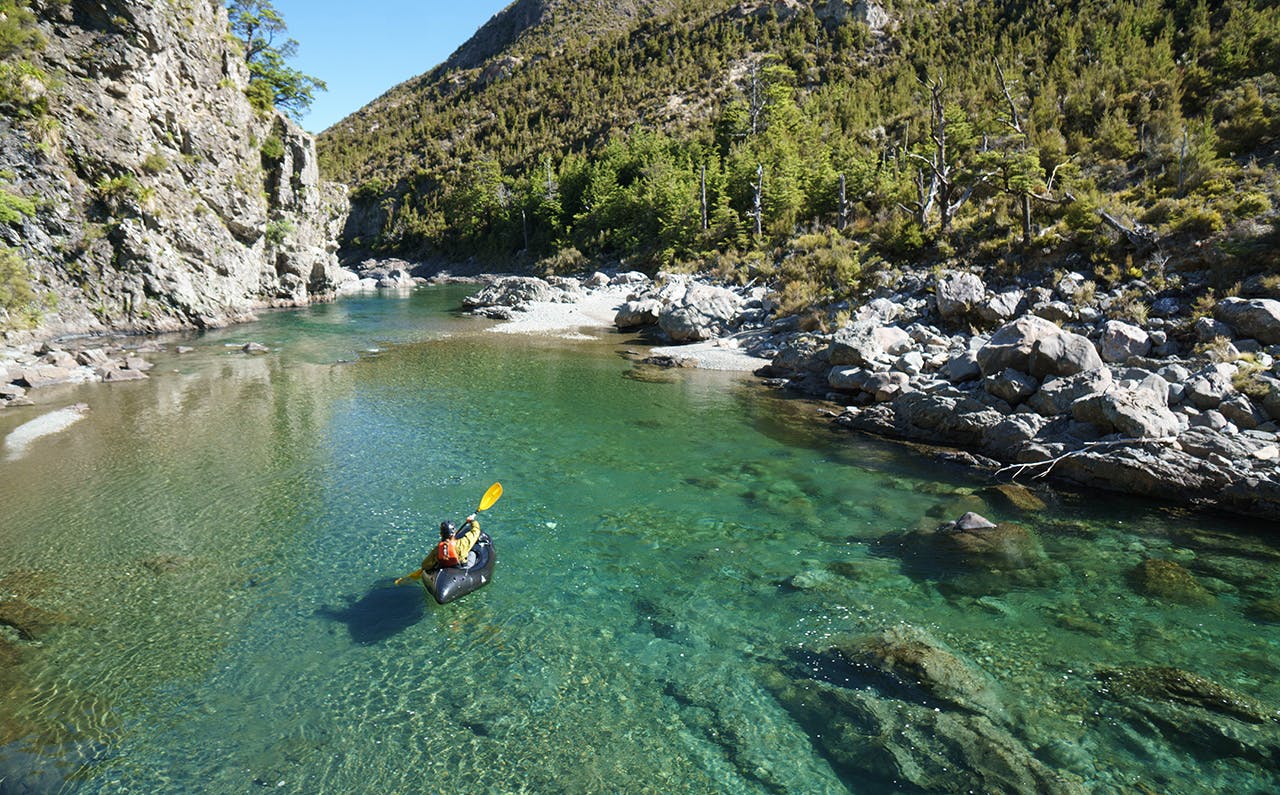
Packrafting a remote stretch of the Rangitikei River. Photo: Thor Tingey
Despite the seemingly rugged nature of packrafting, you don’t have to be an expert paddler to get into it. Trevour Pitt from Te Anau says that while it’s definitely helpful to have some experience in whitewater, it’s not crucial. He’s more into the tramping side of packrafting and uses his raft as a means to see more of the backcountry. He says it completely changes the access to a place.
“It let’s you [explore] in a more interesting and efficient way,” Pitt says. “I think of it as a tool to go to places, rather than an end in itself.”
He says it opens up a new way to experience areas like the Hollyford. “The Hollyford-Pyke circuit is not what I would call a great tramp, but it’s a great packraft loop. You have two rivers that run in two valleys in opposite directions with a bit of walking in between. It makes perfect sense to take a raft because instead of crashing through scrub along the river, you can be on the river floating along,” Pitt explains.
Pitt got into packrafting after following Alaskan adventure races, where the participants often use packrafts to get through particularly rough terrain. He bought his raft in 2011 and has been exploring backwaters in New Zealand ever since.
It’s not too hard for newbies, Pitt says. Dropping in on placid waters and portaging around the bigger whitewater is relatively easy in a packraft, as it only takes a few minutes to inflate and deflate the rafts. The ease of taking it out and putting it away makes it possible for those with fewer whitewater skills to skirt those areas that look daunting. But if you are braving the rapids, Pitt says packrafts are more stable than kayaks, with wider and flatter bottoms, and are “a bit more forgiving”.
“Once you have a packraft, you look at terrain quite differently,” Pitt says. “It changes your whole perspective. He says when he’s planning a trip, he looks for places that offer a good combination of tramping and paddling.
“Being on the tramper side, I always want to make sure it’s worthwhile to carry the extra five kilos.” He says other packrafters he knows who are more into paddling will opt to carry their rafts for three days, even if there’s potentially only half a day of paddling. That’s not his style, but he appreciates the multi-sport opportunities in places where sections of rough tramping can be skipped by using a packraft.
“It allows you to look at maps in a whole new way,” says Arno Marten, owner of Expedition X, a packrafting company based in Queenstown. Marten’s company takes tourists on day trips in the Rees Valley and multiday trips in Fiordland National Park. The Fiordland trip takes six days, and ventures up the Hollyford and Pyke. What is normally a 10-day journey on foot is cut virtually in half when traveling by packraft. The sport is gaining popularity, according to Marten, who says he gets calls and emails regularly from people wanting to go on one of his trips or enquiring about how to rent or buy a packraft.
The first-ever packrafting meet-up was in January this year, during which about 30 Kiwi and international packrafters met in Murchison to float the Landsborough and Clarence rivers. Avid packrafter and National Outdoor Leadership School (NOLS) instructor Dulkara Martig organised the event, which she said helped foster a sense of community among packrafters. She’s well-versed in the sport, having led a packrafting trip for NOLS in Alaska.
“Packrafting in New Zealand is the equivalent of what it was in Alaska a decade ago,” Martig says, reflecting on how it’s still quite a new sport here. Martig, based in Nelson, says New Zealand is rife with opportunities for packrafting, and says she expects it will continue to grow as more people discover how versatile it is.
“You can take the most obscure creek and have a really epic tramping trip and combine it with packrafting,” she enthuses.
Martig’s trip planning is “a bit random”, as she’ll often choose off-trail routes, involving catchment areas where she wants to explore. She’s also a fan of source-to-sea trips: “You climb a mountain, and you start paddling as soon as you can paddle. It’ll get you to places that you never would have gone before.
“It’ll make you plan more creative trips, spend more time off-trail and in turn develop navigation skills.” She adds it’s a great sport for families, saying it’s possible to fit kids in the front of a raft, so long as the rapids aren’t too formidable.
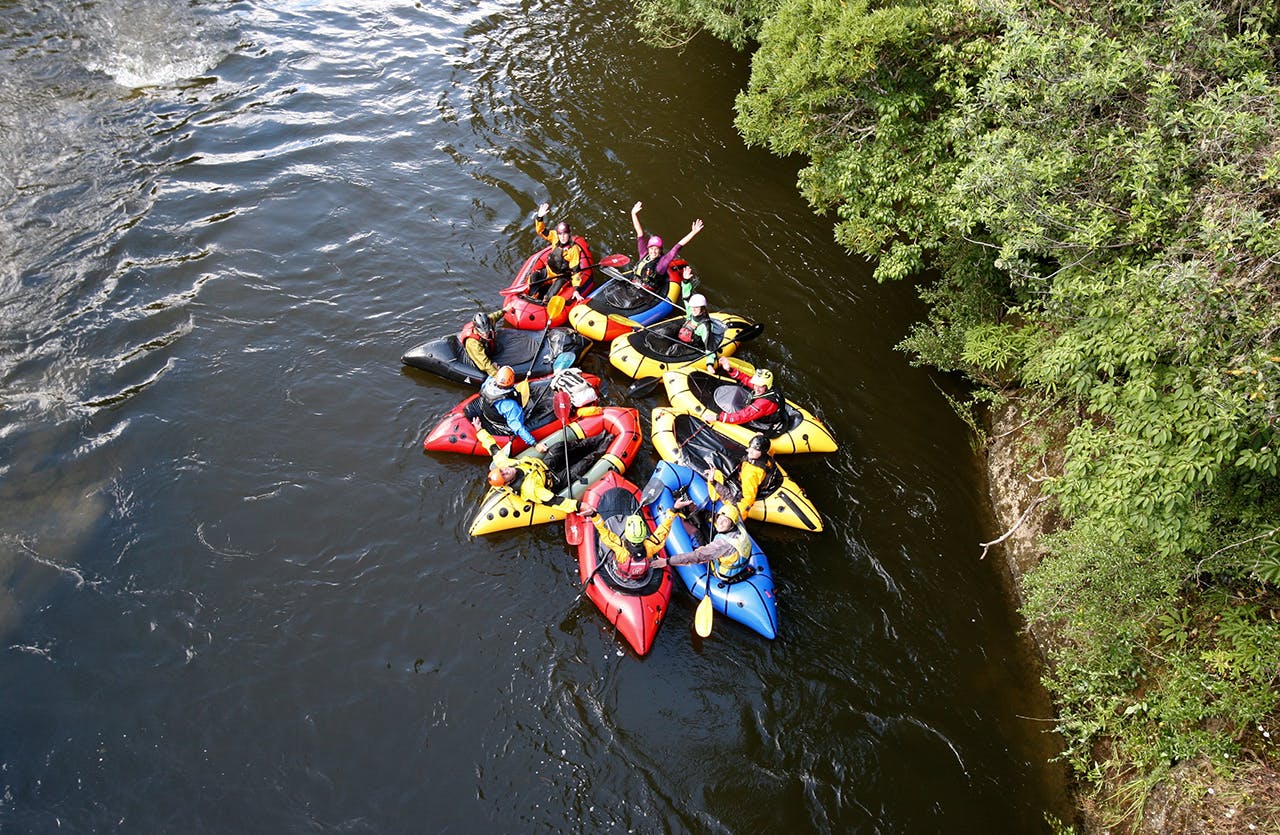
Packrafters congregated on rivers around Murchison for the first Meetup held in January 2016. Photo: Janine Martig
Unless you plan on sticking to flat water, Martig recommends packrafters have proficient river-running skills in a kayak before taking up the sport. She also says it’s important to be able to self-rescue because coming to the aid of others can be difficult on a river. Packrafts can float away quite quickly when empty, and Martig once had to chase a raft for over a kilometre to retrieve it. The rafts don’t come with leashes, as it’s safer to let the raft drift away than be dragged downstream alongside it.
Her other top advice to novices is to test out your equipment and become confident reading water and manoeuvring a packraft on roadside river runs before heading out on more technical wilderness trips.
If you’re a newbie to whitewater, Martig recommends testing out trips that have trailside access. “It provides an easy ‘escape’ route and is less committing than a trip that’s pure wilderness. If a stretch of water is above your level of competence or confidence, you’ll be more likely to get out and walk if there’s a track. In other places, where there’s no track, it can be a ridiculously gnarly bush-bash,” Martig says.
In January, Martig and some friends packrafted the Landsborough River, and ended up stuck on the bank next to the river due high water levels. Unable to raft the gorge, the group was forced to bush-bash out on foot and were three days overdue. “Off-trail navigation skills are pertinent for people doing remote trips as you always need a backup option if rivers get too flooded.”
Martig is an experienced tramping and whitewater kayaker and is adamant that packrafting offers the best of both worlds. “It adds a different dimension on normal hiking trips. It puts in a little bit of adrenalin, more problem solving, and more navigation.”
Vaughn Filmer is harnessing the teaching element of packrafting in his job as an outdoor education teacher at Fiordland College in Te Anau. He’s been introducing his Year 12 students to the sport, setting them loose on the Waiau River.
“It’s new and exciting, and for us in Te Anau it makes sense,” Filmer explains. “We have such perfect conditions for it. And because the boats are stable, the kids get comfortable right away.” So far, Filmer’s just taken them on day trips around Te Anau. But he’s gearing up to take them on the Hollyford-Pyke.
“It’s all about the journey,” he says. “Rather than just learning skills, they learn along the way.” Filmer says packrafting adventures help kids learn about self-sufficiency. And compared to taking the students kayaking, packrafting is easy – no trailers, no difficult portaging – you just inflate your raft and go.
On a personal note, Filmer loves his packraft. He says it allows him to get to places he would have otherwise overlooked. “All of a sudden, I can do these trips that I’ve always wanted to do, and in a shorter time span.” Not only does it cut out less-favourable sections of tricky tracks, he says it sheds an entirely new light on the journey.
“It’s cool being on the water – you’re out of the bush so the views are stunning. Paddling out onto a lake, you might be surrounded by mountains, which you otherwise wouldn’t see.” It’s not all about big water for Filmer. “For me, it’s a tool for exploring.”
Give it a go!
Trevour Pitt highlights some of the best packrafting trips in New Zealand
Waiau-Kepler Loop
Beginner / Class I/II / 1-2 days
A nice gentle float from the control gates to Shallow Bay on Lake Manapouri with a walk back along the Kepler Track. Either do it in a day or stay at Shallow Bay Hut or Moturau hut. A good introductory trip.
Hollyford-Pyke Loop
Intermediate / Class I/II (more difficult rapids can be portaged) / 4-6 days
The trip starts and finishes at the Lower Hollyford Road end. Given light winds and favourable tides, it is possible to paddle from the road end all the way to Martins Bay Hut. If you strike a head wind on Lake McKerrow just pack up your boat and hit the trail. From Martins Bay, walk the coast to Big Bay, being careful not to step on seals, and continue on to the Pyke. Inflate your boat again and paddle the Pyke to the Hollyford confluence, crossing Lake Wilmot and Lake Alabaster on the way. It’s then an easy walk back to the car.
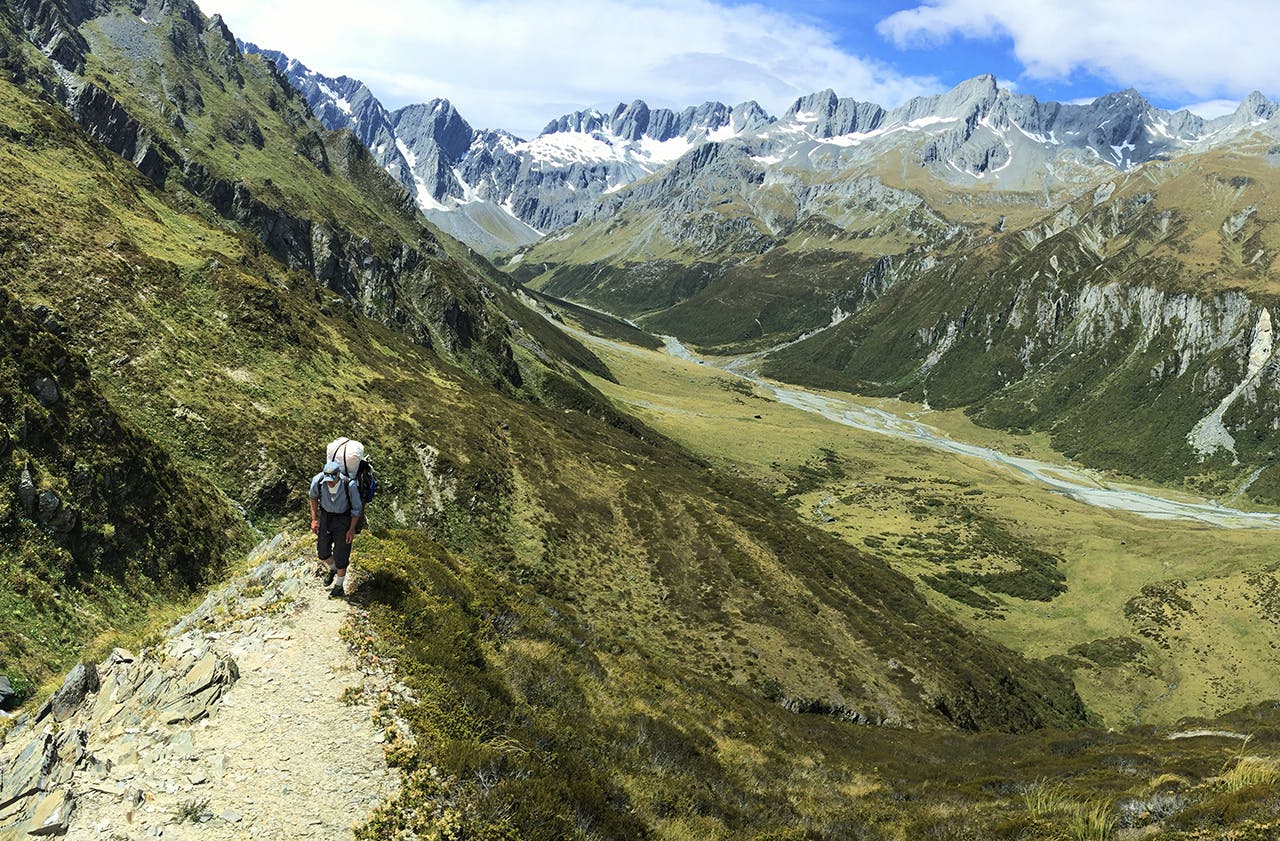
A packrafter carries his boat over Brodrick Pass. Photo: Thor Tingey
Landsborough via Brodrick Pass
Advanced / Class IV / 3-4 days
From the Lake Ohau Road end, walk up the Hopkins Valley, past Monument Hut (4WDs can make it this far) and on to the Huxley Valley Track. Continue on past Brodrick Hut and over Brodrick Pass into the Landsborough.
Put in here or walk upstream to Kea Flat. There are plenty of class II and III rapids on the way to Upper Gates Gorge and quite a few larger rapids in the gorge where most packrafters will choose to portage.
The lower section braids out before meeting the end point at Clarke Bluff on the Haast Pass Highway.
Low water levels are required for packrafting the Landsborough – it is a frightening river in flood.
Waiatoto via Pearson Saddle
Expert / Class IV / 4-6 days
Start at Makarora and either paddle or walk up the Wilkin River to Kerin Forks (alternatively, save time and take the jet boat).
Continue up the Wilkin, passing Top Forks Hut on the way to Waterfall Flat. At the top of the Waterfall Face, wander up the Wilkin then head west over Pearson Saddle and into the Waiatoto.
The Waiatoto has plenty of class II and III water with harder rapids in the gorges, which most packrafters will choose to portage. Low water levels are required for packrafting – the Waiatoto should be avoided if in flood.
The lower section is a gentle float down to the bridge on the Haast Jackson Bay Road.





